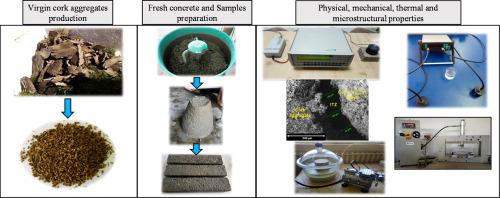Construction and Building Materials ( IF 7.4 ) Pub Date : 2020-09-11 , DOI: 10.1016/j.conbuildmat.2020.120734 Ahmed Kamel Tedjditi , Fouad Ghomari , Omar Taleb , Rafik Belarbi , Rachid Tarik Bouhraoua

|
This paper examines the potential to develop a lightweight concrete for building applications using cork aggregates. The main contribution of the proposed work is the use of virgin cork, which presents, compared to reproduction cork, different structure, density and surface type so that it has insufficient quality for cork stoppers. The experimental work was carried out by producing four concrete mixtures containing, in volume of aggregates: 25, 50, 75 and 100% of virgin cork aggregates. Cork concretes were assessed and compared with an ordinary concrete in terms of: workability, plastic viscosity, density, ultrasonic pulse velocity (UPV), porosity, capillary absorption, mechanical properties, microstructure and thermal conductivity. The experimental work shows that the incorporation of virgin cork into concrete reduces its workability and plastic viscosity and produces lightweight concretes with density lower than 720 kg/m3. Remarkably, depending on virgin cork amount, the increase of concrete porosity varied between 26 and 470%, compared to ordinary concrete. When replacing the totality of mineral aggregates, concretes showed values of only 0.48 and 0.72 MPa for compressive and flexural strength, respectively. Nonetheless, for non-structural materials, these mechanical strengths can be considered as competitive. Investigation of the Interfacial Transition Zone (ITZ) between cork aggregates and cementitious matrix revealed porous layer with thickness ranging between 90 and 150 µm. In terms of insulation capacity, the use of virgin cork leads to enhance thermal conductivity of concrete by 28–98 %, depending on cork percentage. Findings suggest that the developed virgin cork concretes can be used in several building application, namely, as filling blocks and insulation screeds.
中文翻译:

在开发新型轻质混凝土中使用原生软木作为骨料的潜力
本文探讨了使用软木骨料开发用于建筑应用的轻质混凝土的潜力。拟议工作的主要贡献是使用了原始软木塞,与再生软木塞相比,原始软木塞的结构,密度和表面类型不同,因此对于软木塞而言质量不足。通过生产四种混凝土混合物进行实验工作,这些混凝土混合物的骨料体积分别为:25%,50%,75%和100%的原始软木骨料。对软木混凝土进行了评估,并在以下方面与普通混凝土进行了比较:可加工性,塑性粘度,密度,超声脉冲速度(UPV),孔隙率,毛细吸收,机械性能,微结构和导热率。3。值得注意的是,取决于原始软木的数量,与普通混凝土相比,混凝土孔隙率的增加在26%至470%之间变化。当取代全部矿物骨料时,混凝土的抗压强度和抗弯强度分别仅为0.48和0.72 MPa。但是,对于非结构材料,这些机械强度可以认为是具有竞争力的。对软木聚集体和水泥基体之间的界面过渡区(ITZ)的研究表明,多孔层的厚度在90至150 µm之间。在绝缘能力方面,使用原始的软木塞可以使混凝土的导热率提高28–98%,具体取决于软木塞的百分比。研究结果表明,所开发的原始软木混凝土可用于多种建筑应用,即











































 京公网安备 11010802027423号
京公网安备 11010802027423号